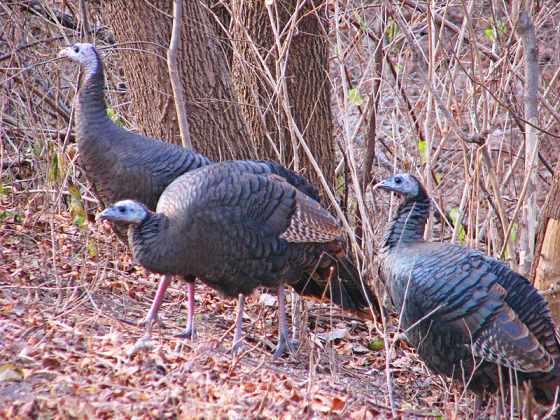
Even though the title of this post sounds as if it should have something to do with the Thanksgiving holiday, it doesn’t. It’s about turkeys in their natural habitat, not on someone’s dinner table to be eaten for a feast.
Turkeys are strange creatures. They waddle instead of walking. For large animals with spindly legs — they can grow to be 30 pounds and attain a height of 4 feet — turkeys can move pretty quickly.
For many years, there were few wild turkeys in Massachusetts. Having been hunted nearly to extinction, a little assistance was needed to help them to reproduce and flourish in the state. In 1972 and 1973, the state Division of Fisheries and Wildlife released 37 turkeys in the Berkshires to reintroduce them to the area. Resurrecting this species would have been a good idea if the birds hadn’t decided to take up residence in suburban and sometimes even in urban areas.
As time passed, the turkeys became increasingly bold. Flocks of them could be seen feeding on a front lawn, close to the front door of an occupied house. Even the sounds of human life emanating from the house didn’t disturb them.
Not too many people mind watching these huge birds strut around. For the most part, they are just a curiosity. However, as they have grown used to humans, they have become more aggressive.
One place where there have been a lot of complaints about aggressive turkeys is in Brookline, Massachusetts, a place where I frequently ride my bike. In that town, turkeys have been known to attack people by jumping on them or charging at them.
Children have been chased by the birds, And, I even read on the ABC News website that “One [Brookline] officer said he spends nearly every morning protecting students at Brookline High School from the turkeys.” It’s gotten so bad that school children need armed guards to protect them from these birds.
School children are not the only ones to get attacked. The turkeys have become territorial in Brookline and have been seen chasing cars, cyclists and joggers.
If they catch up to their target, the turkeys may jump up on them, kick them using the spurs on the back of their legs as weapons or bite them. Naturally, to a driver, this behavior would be nothing more than a nuisance. But for a jogger or a cyclist, it’s a whole other story.
I have crossed paths with turkeys when riding my bike through Brookline. For the most part, they simply looked up from their foraging and watched me with curiosity. They felt no desire to attack me, for which I was relieved. Yet, they could easily have chased me as I’ve heard they’ve done to a number of other cyclists.
Being chased by a 30 pound bird is no joke. Should that bird jump up on a cyclist while he or she is riding along a road, it could easily knock the cyclist into traffic or just knock them off their bike.
This problem is becoming an increasing hazard in places like Brookline. And it comes at a time when coyotes have already invaded and a black bear was spotted roaming around the town.
According to the police, people should discourage the turkeys from becoming too used to humans by scaring them. Yelling and coming at them with an open umbrella are among the techniques recommended by the police. This, however, won’t work particularly well if you’re riding a bike.
A cyclist could try to fend off an aggressive turkey by swinging a pump at it, or even kicking it, assuming that the cyclist isn’t going too fast. After all, getting attacked while astride a moving object can be a life or death situation.
In case any cyclists feel guilty for fighting off an aggressive bird, they should keep in mind that it is legal to hunt turkeys in Massachusetts. Strict rules have been enacted for when and how a person can kill a turkey. Only a shotgun or bow and arrow can be used to kill the birds — which doesn’t help much if a cyclist is being chased by one of them and needs to defend himself.
By reducing the amount of open land, we are encouraging wildlife to move into heavily settled areas. Despite the planning and a push for more bicycle accommodations in our cities and towns, no provisions have been made for dealing with wildlife.
Bicycle advocates can hardly dictate to lawmakers how cyclists should deal with attacks from animals. But, they could at least make it known that a cyclist might need to injure a turkey — or other animal — to protect himself.
For now, cyclists will have to ride as fast as they can to get past roaming animals. Avoiding a confrontation is the best way to insure safety for all parties.



